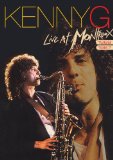In 1987 Kenny G had released three albums already, but most of the world still didn’t know who he was. He was already an accomplished musician who had played as part of Barry White’s orchestra. He had dreams of taking his talents a bit further than that. But it’s incredibly hard to get on the pop charts with instrumental music. It doesn’t happen very often. That’s not to say that it’s unheard of. There have been a few instrumental pieces and musicians that have found huge success riding the international pop charts. Up until now Kenny G could not be counted as one of them.
All of that changed with the release of Duotones and the single Songbird. Both captivated the mainstream audiences and began to garner serious attention for the sax player. One of the results of that new-found recognition was an introduction to the world famous Montreux Jazz Festival. You had to show something to be invited to that stage. Kenny G appeared there in both 1987 and 1988. This DVD captures both of those performances. Fans won’t need much of an inducement to pick up the release. It was an historic moment for the musician and his mostly Seattle-based band. It was the introduction of Kenny G to the world stage.
The two concerts are very different. In 1987 Kenny G didn’t have the confidence that he would later exhibit. The band was larger, perhaps acting as a tighter security blanket for the young musician. There was very little talking to the crowd during the 1987 concert. He did spend one number roaming the crowd. It’s a stunt he likely would not have been able to do when he was better known. The crowd appears to enjoy the interaction, but it’s obvious they’re not attempting to get to him.
By 1988 Kenny G had begun to enjoy the fame a hit record brings. He is far more talkative and carries himself with a ton more confidence. The core of his band remained the same for both shows, but the 1988 concert was a much smaller band featuring only the core players of John Raymond (guitar), Vail Johnson (bass), and Robert Damper (keyboards) from the 1987 show. The 1987 show features a guest appearance by jazz keyboard legend George Duke.
The music is about what you might expect. Unfortunately the material does get a bit too self-indulgent for my tastes. I like jazz fine, but long drawn-out jams of the same basic melody get exhausting in very short order. Kenny G shows off his musicianship at times with frantic riffs that reveal stunning technical ability but soon become a strain on the ears. He’ll run a riff so maniacally that his sax begins to sound like an electronic synthesizer from the 70’s. I guess the fans are going nuts during such moments, but that puts this release in the more limited category of being strictly for the fans.
Video
Both concerts are presented in an expected full frame format. The stage is rather dark and lacks many of the rock concert trappings, including huge lights and lasers. It has a club feel. That means the compression issues will cause problems here from time to time. Some of the faraway shots look like a multiple videotape dub. There are some rather sweet close-ups. That’s where the image presentation stands out. Here we get far cleaner pictures. The detail is enough to tell the time on his watch and watch the sweat running on his face.
Audio
The Dolby Digital 5.1/DTS 5.1 tracks sound pretty identical here. Perhaps there is more bottom on the DTS track. The music is clean and sounds as good as any live CD I’ve heard over the years. It’s obvious that you’re getting soundboard feed here. The audience sounds quite reserved, but that’s because you’re likely hearing them through the stage mics. Since there are no vocals, except in one song, there aren’t the number of open stage mics you usually find at a concert. It also leads to a rather smooth sound presentation throughout.
Special Features
Nothing
Final Thoughts:
If you’re a fan of Kenny G, I don’t have to tell you to add this one to your collection. If you’re a jazz fan in general, you might find this a worthy addition to your collection. Kenny G is the kind of jazz player who hasn’t conformed his style to a pop culture. That makes the material far more authentic than most cross-over musicians. I guess you could call him “somewhere between Barry White and Smokey The Bear”.





